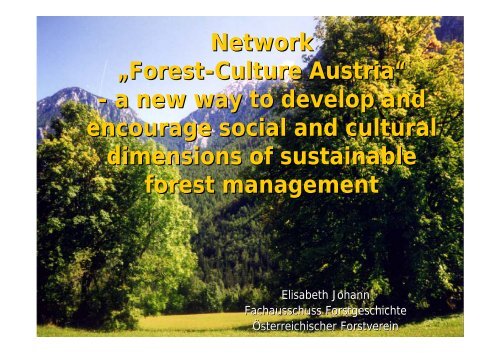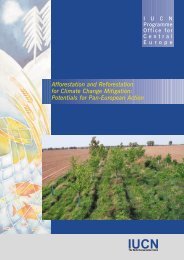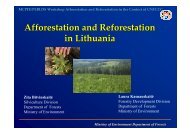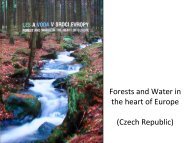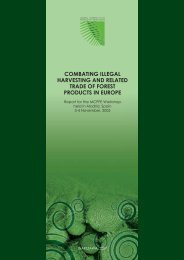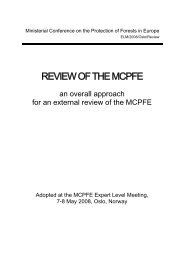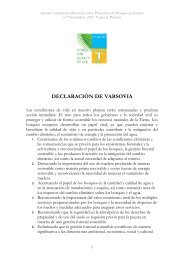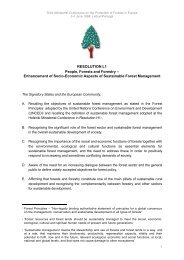Elisabeth Johann - Forest Europe
Elisabeth Johann - Forest Europe
Elisabeth Johann - Forest Europe
Create successful ePaper yourself
Turn your PDF publications into a flip-book with our unique Google optimized e-Paper software.
1. Introduction• Austrian‘s s forests have always beenand are still the most characteristicelement of the landscape (>47% ofthe territory)• The woodland and its products(energy and nutrition) were theprecondition for the welfare of thepopulation from the first settlementstill the 1850ies• Already from the 16th centuryonwards a remarkable shortage offuelwood caused by high industrialdemand gave raise to thedevelopment of sustainable forestmanagement and legislation13-15 15 June 2005Seminar on <strong>Forest</strong>ry and OurCultural Heritage 3
Landscape protection in the 19th century• Protection of natural landscapes andmaintenance of artefacts and monumentsof cultural heritage• Protection, maintenance, promotion andsecuring of nature just for itself• Emphasis on the ethical, aesthetical andsocial values of forests beside theireconomical importance.13-15 15 June 2005Seminar on <strong>Forest</strong>ry and OurCultural Heritage 5
2. Implementation and strengtheningof the cultural performance andpotentials of Austrian‘s s forestry• 2.1. Starting point• 2.1.1. <strong>Europe</strong>an commitments• 2.1.2. Global development• 2.1.3. Development of Austrian's forestry• 2.2. Goals13-15 15 June 2005Seminar on <strong>Forest</strong>ry and OurCultural Heritage 6
13-15 15 June 20052.1. Starting point2.1.1. <strong>Europe</strong>an commitments:• 4th Ministerial Conference on the Protection of<strong>Forest</strong>s in <strong>Europe</strong> 28-30 April 2003 Vienna• The “Vienna Living <strong>Forest</strong> Summit Declaration:<strong>Europe</strong>an <strong>Forest</strong>s – Common Benefits, SharedResponsibilities” emphasises that co-ordination ordination andpartnerships leading to shared responsibilities arecrucial for the provision of common benefits fromforests in the future.• The representatives of the Signatory States and the<strong>Europe</strong>an Community committed themselves to• Benefiting rural livelihood and urban societies• Building strong partnerships• Tackling global challenges• Putting MCPFE commitments into actionSeminar on <strong>Forest</strong>ry and OurCultural Heritage 7
Austrian <strong>Forest</strong> Dialog• An interdisciplinary and inter - sectoral dialogbetween all forest – relevant sectors andstakeholders• Provides the framework for concrete forest –political strategies• Basis for the „Austrian National <strong>Forest</strong> Program”• Social and cultural aspects of sustainable forestmanagement are discussed in chapter 3(Environment and Society) of this dialog and areaddressed at all levels13-15 15 June 2005Seminar on <strong>Forest</strong>ry and OurCultural Heritage 9
Social and culturalaspects of sustainableforest managementArt: (Painting, Literature, , Music,Sculptures ect. . )13-15 15 June 2005Seminar on <strong>Forest</strong>ry and OurCultural Heritage 10
Social and cultural aspects of sustainable forestmanagement• • Landscape(Traditional utilization practises i.e. pollarding)13-15 15 June 2005Seminar on <strong>Forest</strong>ry and OurCultural Heritage 11
Social and cultural aspects of sustainable forestmanagement• Wood processing • Wooden architecture13-15 15 June 2005Seminar on <strong>Forest</strong>ry and OurCultural Heritage 12
Social and cultural aspects of sustainable forestry• Tradition13-15 15 June 2005Seminar on <strong>Forest</strong>ry and OurCultural Heritage 13
Social and cultural aspects of sustainable forestmanagement• Sights and monuments13-15 15 June 2005Seminar on <strong>Forest</strong>ry and OurCultural Heritage 14
Social and cultural aspects of sustainable forestmanagement• Recreation (health, well-being i.e.)13-15 15 June 2005Seminar on <strong>Forest</strong>ry and OurCultural Heritage 15
2.1.2. Global development• In 1972 the General assembly of UNESCO hasagreed the convention concerning the Protectionof the World Cultural and Natural Heritage withthe goal to protect the witnesses of past andpresent treasures of cultures and naturallandscapes of excellent beauty and biodiversityand to maintain it as a World Heritage for thebenefit of future generations.• The addressed “World Heritage Sites” aredivided into three categories: Cultural Heritage,Natural Heritage and Cultural Landscape.13-15 15 June 2005Seminar on <strong>Forest</strong>ry and OurCultural Heritage 16
2.1.3. Development of Austrian‘s<strong>Forest</strong>ry13-15 15 June 2005• The economic situation of therural population ischaracterized by aremarkable loss of income(low price for agrarianproducts, high price forenergy)• farms become abandoned,farmers are migrating to theneighbouring agglomerationcentres• the still existing ruralinfrastructure is increasinglyvanishingSeminar on <strong>Forest</strong>ry and OurCultural Heritage 17
• The sustainable management ofthe mountain forests and themaintenance of the culturallandscape are increasinglyendangered.• This is also due to the fact, that85% of the forest land is inprivate ownership; about 70% ofit is small scale farming.• The dogma – taught at forestryschools almost up to date times- that the profit margin earnedby the selling of timber issufficient enough to offer themultiple benefits of forests toeverybody free of charge is notvalid any more.13-15 15 June 2005Seminar on <strong>Forest</strong>ry and OurCultural Heritage 18
2.2 Goals• <strong>Forest</strong>ry has to work towards an improvedunderstanding and to establish partnerships within civilsociety in order to enhance public awareness andunderstanding of the multiple benefits of forests forsociety and its contribution to the overall well-being ofsociety.• By an increasing social appreciation of qualified benefit-based forest management forest enterprises might beable to achieve other sources of income beside timber.• It is necessary to find sources of income resulting fromservices which are demanded by the society and offeredby forestry.13-15 15 June 2005Seminar on <strong>Forest</strong>ry and OurCultural Heritage 19
3. Network „<strong>Forest</strong>-CultureFoundation:13-15 15 June 2005Austria“• 2002 by the Austrian <strong>Forest</strong> Association (Working party <strong>Forest</strong>History) and the Ministry of Agriculture, <strong>Forest</strong>ry, Environment andWatershed Management.Need:• Present time forestry is based on a long history of forest-culture• There is a substantial public and private interest in maintaining g thetraditional monuments and elements of forest utilization practisesand to make these historical information accessible to the public• There is a loss of past knowledgeMembers:• The network joins together• Scientists• Institutions• <strong>Forest</strong> enterprises• Various stakeholders being involved in forest cultureSeminar on <strong>Forest</strong>ry and OurCultural Heritage 20
Network „<strong>Forest</strong>–CultureAustria“Important institutions andstakeholders in Austria<strong>Forest</strong>enterpriseFarmforestryMuseumCommunityTourismgovernment<strong>Forest</strong>associationVariousinstitutions13-15 15 June 2005Seminar on <strong>Forest</strong>ry and OurCultural Heritage 21
13-15 15 June 2005<strong>Forest</strong>-Culturein Austria• <strong>Forest</strong> culture deals withthe multipleinterrelationship betweenforests, forestmanagement and thehuman society, which havechanged in the course ofhistory.• It is not only confined todemonstrating historicaldevelopments, butcontributes alsoconsiderably to a betterunderstanding of thepresent situation of forestsand the development ofthe cultural landscape.Seminar on <strong>Forest</strong>ry and OurCultural Heritage 22
13-15 15 June 2005<strong>Forest</strong>-Culturein Austria• Hunting, bee-keeping,fishing, timbermanagement, limeburning, resin tapping,charcoal burning, but alsotransport, utilisation oflitter, forest pasturage,animal husbandry, fruitgrowing are just someexamples of partlytraditional partly historicaltypes of forest utilisationand the resulting typicalforest stands.Seminar on <strong>Forest</strong>ry and OurCultural Heritage 23
<strong>Forest</strong>-Culturein Austria• Due to these types of landuse, which have beenpractised over centuries, firstrank cultural objectives suchas fortresses, castles andchapels could be preserveduntil present time.• The increasing interest of thesociety in such objects offorest culture offers alsoadditional sources of incometo forest owners.13-15 15 June 2005Seminar on <strong>Forest</strong>ry and OurCultural Heritage 24
<strong>Forest</strong>-Culturein Austria• Innumerable generations ofpoets, painters, composers andartist craftsmen have gainedinspiration from the diversity offorests.• The pious ness of thepopulation, historic events andthe close relation of men to theforest have left a wide variety ofcultural assets: Places ofpilgrimage, memorial trees withpictures or inscriptions shrines,tablets with pictures andinscriptions in memory of aperson killed in an accident,wooden or stone niches with acrucifix or saint’s s image, chapelsect.13-15 15 June 2005Seminar on <strong>Forest</strong>ry and OurCultural Heritage 25
<strong>Forest</strong>-Culturein Austria• Today a considerablenumber of museumsand educationalinstitutions dedicatetheir work to forest,environmental andregional history.• There is a longtradition of forestscience and education13-15 15 June 2005Seminar on <strong>Forest</strong>ry and OurCultural Heritage 26
Network „<strong>Forest</strong>s–Culture Austria“:Platform and networkInput: Collection and aggregation of historyrelatedinformationEnterprisesLibrariesResearchArchivesHistoricalelements oflandscapeMuseumNetwork „<strong>Forest</strong> –Culture Austria“Platform and network„To usethechallengeofhistory as an instrument forshaping the future. “Farmingculture13-15 15 June 2005Output: ConsumerSeminar on <strong>Forest</strong>ry and OurCultural Heritage 27
Consumer• Enterprises, institutions, stakeholders inthe field of• Science• Policy• Practise• Tourism13-15 15 June 2005Seminar on <strong>Forest</strong>ry and OurCultural Heritage 28
OutputCollection and aggregation of forest-historyhistory-related related dataMaking acquainted with the term „<strong>Forest</strong>-Culture“ in AustriaStirring the discussion in Austria and taking part in the discussion ssion onthe <strong>Europe</strong>an level.Strengthening of the co-operation operation forest enterprises - tourismConsulting concerning the implementation of forest-cultureculture-related relatedinitiatives into practise (museum, trails with forest history-relatedrelatedthemes, charcoal burning, and rafting as an touristy eventInformation about historical methods of utilization and management nt oflandscapes.Consulting with regard to the work out of management concepts basedon long-term development and tendencies in the fields of• Utilisation of the cultural landscape (forestry and agriculture)• Sustainable development• Development of the cultural landscape13-15 15 June 2005Seminar on <strong>Forest</strong>ry and OurCultural Heritage 29
Network „<strong>Forest</strong>s–culture Austria“:Platform and networkPrevious activities• Seminars and workshops tointroduce examples of bestpractise (forest-culture relatedactivities of forest enterprises)to a broader audience (targetgroup forest enterprises)• Workshop targeting differentstakeholders (forestenterprises, tourist enterprises,museums (topic networking)• Workshop focusing on legaland tax aspects of forest-culture-related related activities offorest enterprises13-15 15 June 2005Seminar on <strong>Forest</strong>ry and OurCultural Heritage 30
Previous activities• Organization of an InternationalConference on “Woodland-Cultural Heritage” (Vienna 2004)• Involvement in the „<strong>Forest</strong>Dialog“ by sending experts• Documentation of all institutionsin Austria dealing with forestculture in a broad sense• Journal „News of <strong>Forest</strong> History“• issue 2004 “<strong>Forest</strong>-Culture inAustria”• issue 2005 (in press)Proceedings of theInternational Conference on„Woodland– CulturalHeritage“ Vienna 200413-15 15 June 2005Seminar on <strong>Forest</strong>ry and OurCultural Heritage 31
Present and future activities• An important part of the working program is the setup of adatabank collecting and documenting forest-historyhistory-relevant relicts, artefacts and monuments of cultural andhistorical value on a voluntary basis that means with theagreement and involvement of the forest owner.• Before this collection will start a workshop will be organizedby the network in autumn 2005 in order to clarify thesights which should be protected for the benefit of society.• Further involvement in the „<strong>Forest</strong> Dialog“ by sendingexperts to strengthen the link to tourism, education,research, communication, etc. because the results of the„<strong>Forest</strong> Dialog“ will shape the „Austrian <strong>Forest</strong> Programme“and further on the program rural development.• Consulting activities related to the equipment of a newforest museum in Austria13-15 15 June 2005Seminar on <strong>Forest</strong>ry and OurCultural Heritage 32
4. Convention Concerning theProtection of the World Culturaland Natural Heritage• World Heritage conservation is not only aninstrument for peace and reconciliation, forenhancing cultural and biological diversity, butalso a factor of regional sustainabledevelopment.• New approaches to integrated management ofWorld Heritage have proved successful andpromoted economic growth and benefits to localcommunities.13-15 15 June 2005Seminar on <strong>Forest</strong>ry and OurCultural Heritage 33
Cultural Heritage, Natural Heritage andCultural Landscape in Austria• It was not before 1992 when Austria signed theconvention which was implemented 1993.• Till 2003 Austria has shown 8 World Heritage sites.• Taking into account the size of the country thenumber of World Heritage sites is remarkable.• About 17 further proposals are under discussion.• The overall utilization of the landscape in the pastis the reason why World Natural Heritage sites canhardly be found in Austria, but Cultural Heritagesites and Cultural Landscape.• Tourist enterprises are increasingly advertisingWorld Heritage sites Seminar on and <strong>Forest</strong>ry gain and Ourmore and moreCultural Heritage 34benefits from it.13-15 15 June 2005
5. Discussion• Austrian‘s s forests cover 47% ofthe surface and are predominantancient forests.• As a result they contain anabundance of interesting sites ofmore or less high cultural value.• Small scale forestry which ismostly practised in Austriansforests hardly endangers thesesites.13-15 15 June 2005• The investigation of historicalinteresting objects and sitesreferring to forest utilisation inthe past and the grant of publicaccess to these sites can only berealized satisfactory with theagreement of the owner of theland (farmer or forest enterprise)and therefore voluntarily.Seminar on <strong>Forest</strong>ry and OurCultural Heritage 35
Discussion• However forest enterprises and farmers being interestedin tourist activities are invited to co-operate operate within thisnetwork but nobody should be forced to do it by localauthorities or public interest• Legal protection of forest culture-related related monumentsapart from the convention concerning the WorldHeritage are neither achieved by the government nor bythe Austrian <strong>Forest</strong> Association in order to avoid conflictsbetween the rural (protecting) and the urban(demanding) society.• However <strong>Forest</strong>-Culture should become a trading markof high quality with regard to sustainable forestmanagement as well as to the protection of the culturalheritage.13-15 15 June 2005Seminar on <strong>Forest</strong>ry and OurCultural Heritage 36
A new approach for co-operation operation of forestand tourist enterprises has been developedto improve networking :• <strong>Forest</strong> enterprises should have the planning competenceand leadership in developing new strategies such as themaintaining of cultural interesting sites of high value inthe forest and the grant for public access, the opening offorest roads for mountain biking, nature protection ect.)• A cross-sectoralsectoral attempt by networking with otherinstitutions, the establishment of partnerships to improvethe regional development by gaining synergistic effects(prehistoric artefacts in the forest, establishment of aforest or regional museum). Caused by these activitiesinitiated by the forest enterprise the rural population willbe able to get a higher revenue.• Because of these activities additional sources of supportfor forest enterprises can be expected (program ruraldevelopment).13-15 15 June 2005Seminar on <strong>Forest</strong>ry and OurCultural Heritage 37
6. ConclusionsThe experiences of activities which have been practised sofar have proved some important aspects:• It is important to analyse the suitability of the locationwith regard to the planned activity• It is necessary to offer something special (no competitionwith neighbouring activities but to look for a niche).• The initiative should come from the region.• You have to look for appropriate partners.• In developing forest-cultureculture-related related activities new jobs canbe created in the region.• In rising awareness of the public it is important that theland use is in line with sustainable forest management.• <strong>Forest</strong>-cultureculture-related related activities should also be seen fromthe view of the guest; a routing of visitors is possible.13-15 15 June 2005Seminar on <strong>Forest</strong>ry and OurCultural Heritage 38
Thank you for your attention13-15 15 June 2005Seminar on <strong>Forest</strong>ry and OurCultural Heritage 39


